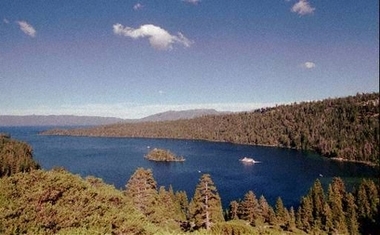Officials are looking to capture some of Lake Tahoe's biggest polluters:
Canada geese.
A sewage spill at the lake last summer "is nothing compared to what's
happening with these geese," said Jack Spencer, a federal Department of
Agriculture wildlife biologist.

Emerald Bay, on the California side of Lake
Tahoe. Experts are blaming some Lake Tahoe pollution on Canada geese. [AP
File Photo] |
Spencer said the bottom of Lake Tahoe is covered by up to two inches of goose
feces in some areas. A 10-pound Canada goose can produce four pounds of nitrate-
and phosphate-rich feces every day it waddles across the beaches, lawns and golf
courses of Tahoe.
The birds find refuge on Tahoe, one of the most protected lakes in the
nation, when they molt their primary wing feathers in the spring and can't fly.
Spencer and other biologists from USDA Wildlife Services hope to trap up to
400 Canada geese at several Tahoe locations this week, at the request of
property owners and managers.
"We only work where we are wanted, where there is damage occuring," Spencer
said.
The geese will be innoculated for disease and released to a wildlife
management area in eastern Nevada. About 1 percent of juveniles may return, and
about 15 percent of adults will return.
The birds are protected by the Federal Migratory Bird Act, but can be hunted.
In recent years, rules have loosened to help urban areas deal with the birds.
The Tahoe roundup is part of a regionwide effort. The geese also pose a
threat to jets flying in and out of the Reno Airport, Spencer said.
Canada geese have stopped migrating in a triangle that includes Tahoe, Reno
and Carson City. Abundant food sources from turf landscaping has resulted in
increased densities within that triangle.
"I guarantee you, in the old days, Lake Tahoe was just a stopover place,"
Spencer said.
Fifteen agencies are involved in the roundup, including the Humane Society,
which will provide food for the captured birds.